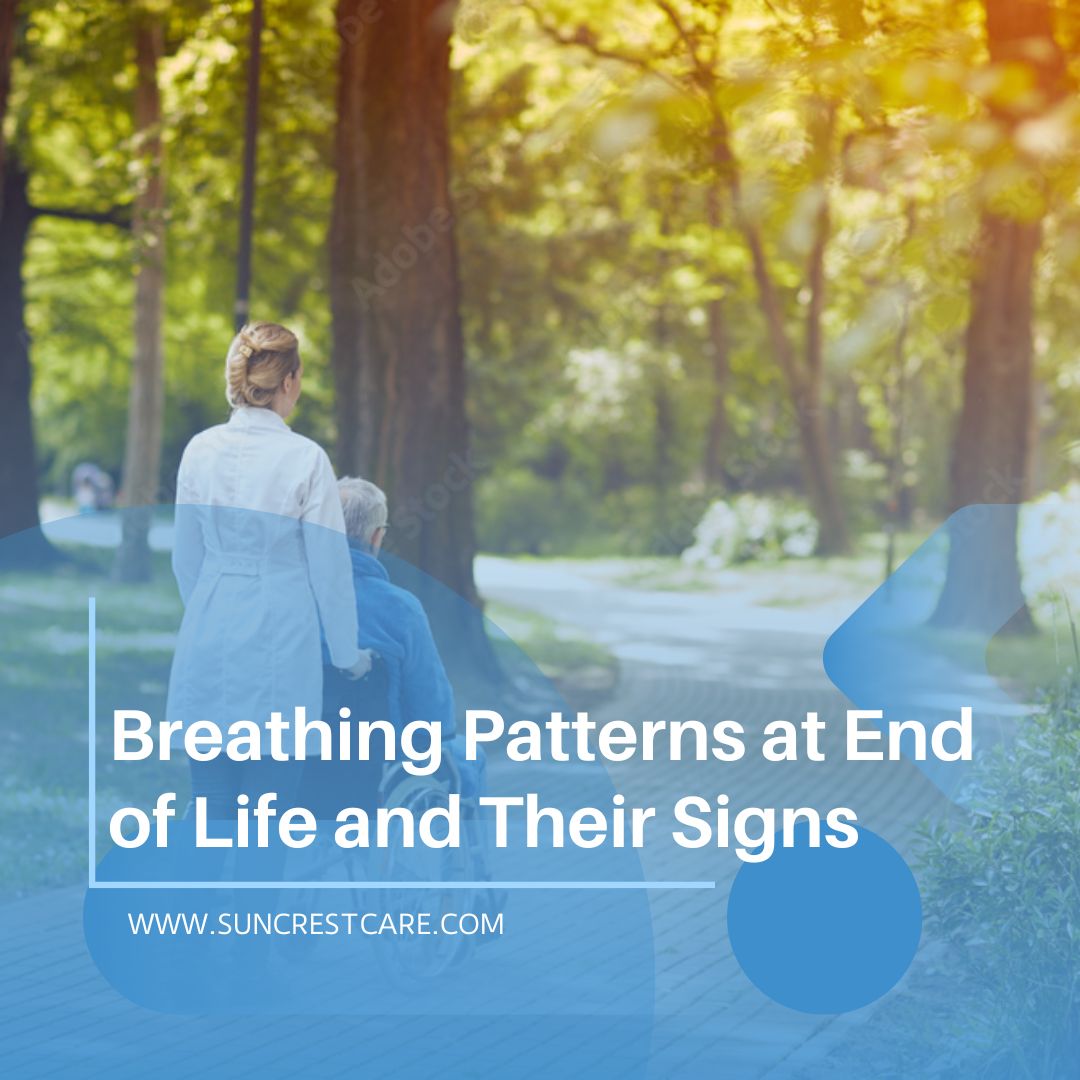When your loved one enters hospice care, you understand that death is approaching, but it is often impossible to know precisely when it will happen. This uncertainty can cause stress and anxiety for family and friends, who may worry about missing important moments. One of the most noticeable signs that the end may be is what we call end of life breathing patterns. At Suncrest Hospice, we share these details to help bring clarity and peace of mind during this challenging time, so you can feel better prepared and supported.
What Is End of Life Breathing?
End of life breathing refers to the noticeable changes in a person’s breathing patterns during the final stages of life. These changes occur as the body prepares to shut down. Families often recognize these shifts, and they can bring both understanding and concern. The changes can be dramatic, which is why knowledge helps families feel more prepared.
End of life breathing may involve breathing that becomes slow, quick, shallow, irregular, or even noisy. Each of these patterns has a specific meaning and place in the dying process. For loved ones, seeing or hearing these changes can be distressing. It helps to remember that these shifts are a natural part of the body’s progression.

Normal Breathing Patterns
Normal breathing is steady and even. In healthy adults, breaths usually range from 12 to 20 per minute. Each breath is smooth, consistent in depth, and without unusual pauses or sounds. At the end of life, this regular pattern changes as the body prepares for death.
Cheyne-Stokes Respiration
Cheyne-Stokes respiration is a common breathing pattern before death. It includes periods of deep, rapid breathing that slowly become shallower, followed by complete pauses, or apneas. After several seconds, the cycle repeats. This breathing can be unsettling to watch but is not painful for the patient. It reflects how the brain’s control over breathing begins to waver.
Agonal or Irregular Breathing
Agonal breathing is marked by gasping or irregular breaths. These breaths can appear abrupt or spaced far apart, often superficial and sometimes accompanied by a slight movement of the jaw. Some describe this as mandibular or “fish out of water” breathing. This type of breathing typically signals that death is very near, often within minutes to hours.
Noisy Breathing (“Death Rattle”)
Noisy breathing, often called the “death rattle” or terminal secretions, is caused by the build-up of saliva or mucus in the back of the throat. The person may be too weak to clear these secretions. As air moves through, it can create rattling or gurgling sounds. While the sound is striking, studies show it does not cause discomfort for the dying person.
Shallow Breathing at End of Life
Shallow breathing at end of life is common. Breaths become lighter, with less rise and fall in the chest. This is a sign that the body’s need for oxygen is dropping. Shallow breathing often alternates with episodes of pauses or apnea.
Labored Breathing in Hospice
Labored breathing hospice teams witness includes visible effort in breathing. This may involve the chest or shoulders rising high, or the use of neck muscles with each breath. Labored breathing before death can be exhausting, but hospice teams focus on comfort. Medications, changing position, or emotional support can ease the sense of shortness of breath.
Quick Guide: Breathing Patterns Table
Table: Breathing Patterns at End of Life and Their Signs
| Breathing Pattern | Description / Signs |
|---|---|
| Cheyne-Stokes | Alternating deep and shallow breathing with periods of apnea (no breath), repeating. |
| Agonal (Irregular) | Gasping, irregular breaths, often jaw movement, unpredictable intervals. |
| Noisy Breathing | “Death rattle” or gurgling sound from secretions; person usually unaware of the noise. |
| Shallow Breathing | Slow, faded chest rise; little air movement; less effort per breath. |
| Labored Breathing | Visible effort; chest or neck muscle strain; breaths may sound difficult or forced. |
| Apnea | Temporary stopping of breathing for seconds or longer between breaths. |

Treatments for End of Life Breathing
1. Create a Calm Environment
- Dim the lights.
- Play soft, soothing music.
- Offer comforting touches, such as holding hands.
- Surround your loved one with familiar items to provide reassurance.
2. Adjust Position for Comfort
- Elevate the head of the bed.
- Place pillows for support under the back and neck.
- Gently turn the person on their side if needed.
- Change positions regularly to drain secretions and ease breaths.
3. Moisturize the Mouth and Lips
- Offer small sips of water if safe.
- Use a moist cloth or oral swabs to keep lips and mouth comfortable.
- Avoid forcing fluids, which can worsen breathing difficulties.
4. Use Medications for Comfort
- Opioids like morphine or dilaudid can slow and ease breathing.
- Anticholinergic medications may help dry out excess secretions that cause noisy breathing.
- All medications are provided to reduce discomfort, not to hasten death.
5. Consider Oxygen Therapy
- Gentle oxygen flow through a nasal cannula may relieve breathlessness.
- Non-invasive options like CPAP or BiPAP may sometimes be needed.
- Hospice teams adjust oxygen based on comfort, not to extend life.
6. Provide Emotional and Spiritual Support
- Speak calmly and offer emotional support.
- Share memories and loving words.
- Invite spiritual advisors, chaplains, or counselors if desired.
- Even if the patient is unresponsive, presence and connection can be deeply comforting.
Other Signs Death Is Near in Hospice
When a loved one is approaching the end of life, changes in breathing patterns often occur alongside other physical and emotional signs. Recognizing these signs can help you know when extra support is needed and provide you with valuable time to be present. Below are some additional signals that death may be near:
1. Reduced Appetite and Refusal of Food or Water
A significant drop in appetite is common. Many people stop eating and drinking altogether in the final days or hours. This is a natural part of the body’s process and does not cause distress.
2. Increased Sleep and Unresponsiveness
Your loved one may spend most of their time sleeping or seem difficult to rouse. As weakness grows, wakeful periods often become shorter and less frequent. Eventually, they may not respond at all to voices or touch.

3. Changes in Mental Awareness or Confusion
Some people experience periods of confusion, restlessness, or agitation. It may be hard for them to recognize familiar faces or surroundings. These changes happen as brain activity slows.
4. Drop in Body Temperature and Skin Color Changes
Hands, feet, and legs might become cool to the touch. Skin can appear pale, blotchy, or bluish, especially on the extremities. These changes are due to decreased circulation.
5. Loss of Bladder or Bowel Control
As muscles weaken, control over bladder and bowels is lost. This is common and natural when the body is near death.
6. Weak Pulse and Low Blood Pressure
The heartbeat may become weak and irregular, and blood pressure often drops considerably. You may also notice shallow or faint pulses at the wrists, arms, or legs.
7. Muscle Weakness or Inability to Move
Moving, sitting up, or even adjusting position becomes challenging. Some people lose the strength to speak or swallow. Muscles may twitch or jerk due to chemical changes in the body.
These signs often occur gradually, sometimes over days or weeks. Suncrest Hospice staff guide families through each stage, offering comfort and answers as needed.

Supporting You Through End of Life Care
The Suncrest Hospice Promise
At Suncrest Hospice, we know how important it is to maintain dignity, comfort, and peace for patients nearing the end of life. Our care team is committed to bringing support not just to patients, but also to the families navigating this difficult time. We stay by your side, answering questions about end of life breathing, managing changes in breathing patterns, and offering guidance through every stage.
We see every patient as a person with a story, memories, and loved ones who want the best care possible. Our nurses, aides, social workers, and chaplains work together to keep your loved one comfortable through simple acts of care, timely medication, and emotional support.
How Our Team Can Help You With End of Life Breathing
Our team responds quickly to new symptoms like rapid breathing before death or episodes of labored breathing in hospice. We listen to your concerns and explain what is happening in clear language. If your loved one has shallow breathing at the end of life or shows signs of the “death rattle,” we help you understand what each pattern means and what to expect.
We adjust care plans as often as needed—whether that means changing your loved one’s position, providing medication for relief, or simply offering a hand to hold. We know that the little things matter and that every moment is precious. You do not have to go through this time alone—Suncrest Hospice walks this path with you.
Contact Suncrest Hospice
Speak With a Caring Hospice Professional Today
Coping with the changes that come at the end of life can feel overwhelming, but you do not have to face them alone. If you notice new breathing patterns—such as rapid breathing before death, labored breathing in hospice, or shallow breathing at end of life—our team at Suncrest Hospice is here to help. We guide families through these moments with kindness, expertise, and ongoing support.
If you have questions about hospice, want to discuss care options, or need immediate guidance, we encourage you to contact Suncrest Hospice today. Our compassionate professionals are ready to listen and provide the information you need.
Call [Insert Suncrest Hospice Phone Number] or Contact Us Online to speak with a member of our care team.
Your comfort, clarity, and peace of mind matter to us. Let Suncrest Hospice support you and your loved ones every step of the way.

FAQs for End of Life Breathing
1. What is end of life breathing, and why does it change?
End of life breathing refers to the changes in breathing patterns that often happen as a person approaches the final stage of life. These changes occur because the body is slowing down, and the muscles involved in breathing become weaker. The brain and organs process oxygen differently in this phase, so breathing may become shallow, irregular, or noisy.
2. Is labored breathing before death painful for the patient?
While labored breathing in hospice can look concerning, it is usually not painful. Most hospice patients are carefully monitored for distress and discomfort. Medications and comfort measures are used to ease any visible effort or anxiety, so the patient does not feel ongoing pain from breathing changes.
3. What is Cheyne-Stokes respiration, and should I be alarmed?
Cheyne-Stokes respiration is a breathing pattern with cycles of deep, rapid breaths followed by slow, shallow breaths and pauses. It is common at the end of life and signals that the body is shutting down. This pattern is not dangerous or painful but can be hard for loved ones to witness. Hospice staff help families understand what it means and how to provide support.
4. How can families help when a loved one has noisy or rapid breathing before death?
Families can help by creating a quiet, calm environment and speaking gently to their loved one. Changing positions, moistening the mouth, and ensuring comfort all help. Most importantly, being present—holding a hand or sitting nearby—often brings the most comfort. Hospice teams are available to guide families on specific comfort steps.
5. When should I call the hospice team about changes in breathing patterns?
You should call the hospice team if you notice any sudden or dramatic changes in breathing, such as new rapid breathing before death, long pauses without breath, or signs of distress like grimacing or agitation. Hospice professionals can assess the situation, provide relief, and answer all your questions—day or night.

